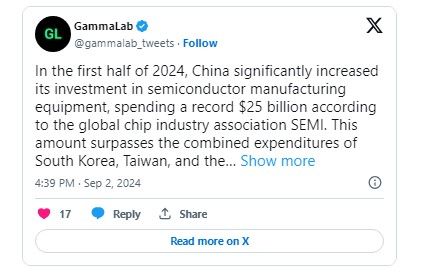
The modern cold war, deeply rooted in the tech world, is escalating as nations compete for dominance in the AI-driven, productivity-boosting era. With the US and its allies set on limiting Beijing’s access to advanced semiconductor technology, China is finding increasingly innovative ways to circumvent these restrictions while enhancing its domestic capabilities.

Nikkei Asia recently reported that China spent an astounding $25 billion on chipmaking equipment in the first half of 2024, setting a new record. What’s even more striking is that this spending spree by China eclipsed the combined expenditure of the US, South Korea, and Taiwan during the same period.
Diving deeper into the details, China accounted for 49.9% of Tokyo Electron’s revenue in the quarter ending in June. Similarly, ASML, Applied Materials, Lam Research, and KLA earned 49%, 32%, 39%, and 44% of their quarterly revenue, respectively, from China’s unrelenting demand for chipmaking tools.
It seems China is stockpiling crucial chipmaking equipment in anticipation of potential escalations in silicon-related sanctions following the upcoming US presidential election in November.
In a related development, China has threatened Japan with severe economic retaliation if it further restricts the sale and servicing of chip-related equipment to Chinese firms, warning that it would withhold essential raw materials and minerals required for automotive production. It’s worth noting that Beijing still holds a diminishing monopoly on the supply of rare earth metals.
As previously reported, China’s homegrown chips are currently keeping pace with the higher-end offerings from companies like TSMC, thanks primarily to more efficient overall design rather than cutting-edge technology. However, there are still no confirmed signs that China can mass-produce chips on sub-7nm nodes.








By Andrej Kovacevic
Updated on 10th March 2025